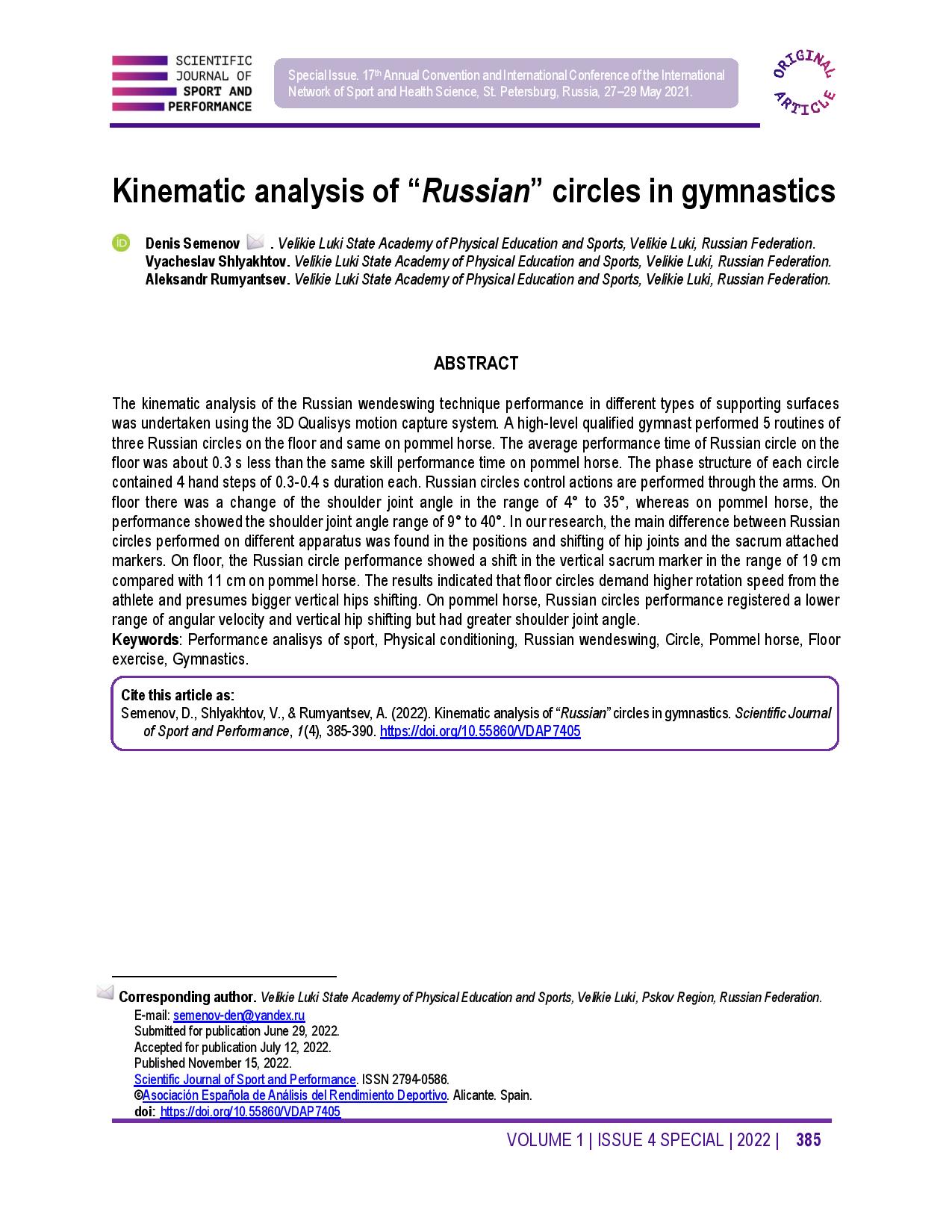Kinematic analysis of “Russian” circles in gymnastics
Main Article Content
Abstract
The kinematic analysis of the Russian wendeswing technique performance in different types of supporting surfaces was undertaken using the 3D Qualisys motion capture system. A high-level qualified gymnast performed 5 routines of three Russian circles on the floor and same on pommel horse. The average performance time of Russian circle on the floor was about 0.3 s less than the same skill performance time on pommel horse. The phase structure of each circle contained 4 hand steps of 0.3-0.4 s duration each. Russian circles control actions are performed through the arms. On floor there was a change of the shoulder joint angle in the range of 4° to 35°, whereas on pommel horse, the performance showed the shoulder joint angle range of 9° to 40°. In our research, the main difference between Russian circles performed on different apparatus was found in the positions and shifting of hip joints and the sacrum attached markers. On floor, the Russian circle performance showed a shift in the vertical sacrum marker in the range of 19 cm compared with 11 cm on pommel horse. The results indicated that floor circles demand higher rotation speed from the athlete and presumes bigger vertical hips shifting. On pommel horse, Russian circles performance registered a lower range of angular velocity and vertical hip shifting but had greater shoulder joint angle.
Article Details

This work is licensed under a Creative Commons Attribution-NonCommercial-ShareAlike 4.0 International License.
References
Baudry, L. Sfirza, C., Leroy, D., Lovecchio, N., Gautier, G., and Thouvarecq, R. (2009). Amplitude variables of circle on the pedagogic pommel horse in gymnastics. Journal of Strength and Conditioning Research. 23 (3), 705-711. https://doi.org/10.1519/jsc.0b013e3181a00be8 DOI: https://doi.org/10.1519/JSC.0b013e3181a00be8
Baudry, L., Leroy, D., and Chollet, D. (2006) The effect of combined self- and expert-modelling on the performance of the double leg circle on the pommel horse. Journal of Sport Sciences. 24 (10), 1055-1063. https://doi.org/10.1080/02640410500432243 DOI: https://doi.org/10.1080/02640410500432243
Fujihara, T., and Gervais, P. (2010). Kinematics of side and cross circles on pommel horse. European Journal of Sport Science. 10 (1), 21-30. https://doi.org/10.1080/17461390903108133 DOI: https://doi.org/10.1080/17461390903108133
Fujihara, T. (2006). Mechanical analysis in mechanism and technique of double leg circles on the pommel horse. Japanese Journal of Biomechanics in Sport and Exercise. 10, 27-41.
Fujihara, T., Fuchimoto, T., and Gervais, P. (2009). Biomechanical analysis of circles on pommel horse. Sports Biomechanics. 8 (1), 22-38. https://doi.org/10.1080/14763140802629974 DOI: https://doi.org/10.1080/14763140802629974
Grassi, G., Turci, M., Shirai, Y. F., Lovecchio, N., Sforza, C., and Ferrario, V. F. (2005). Body movements on the men’s competition mushroom: a three-dimensional analysis of circular swings. British Journal of Sport Medicine. 39 (8), 489-492. https://doi.org/10.1136/bjsm.2003.010256 DOI: https://doi.org/10.1136/bjsm.2003.010256
Qian, J., Su, Y., Song, Y., Qiang, Y., and Zhang, S. (2012). A comparison of a multi-body model and 3D kinematics and EMG of double leg circle on pommel horse. Journal of Human Kinetics. 31, 45-53. https://doi.org/10.2478/v10078-012-0005-9 DOI: https://doi.org/10.2478/v10078-012-0005-9




